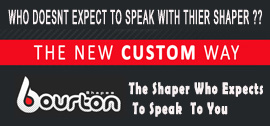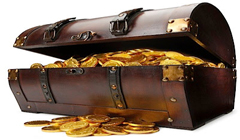Well if you took your eyes off the ball the last year or two then you would be forgiven for asking what are they all about? I have even had some crew expecting to surf with all the 5 fins in at once, so without doubt there is still some lingering confusion over their purpose. To explain how they have evolved I will have to go back to the advent of the 2nd generation of quads that appeared around 2005 popularized by Stretch in the US, Bruce McKee in Europe and myself and others in Oz.
The 2nd generation came out in their pure form as quads and were designed specifically to be ridden as quads. Being from the twin fin family they benefited from having wider noses to get added drive and because they were looser than a thruster they did not need as much rocker. They also, due to the extra leverage created by having 2 fins on rail; could support more meat on the rail which gave the board more drive and added forgiveness. A quad could be ridden shorter because of all the above and that helped enhance paddle.
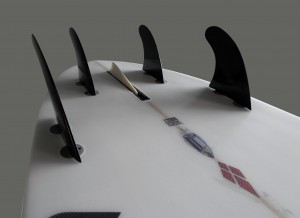 At this point the quad was well on its way to be a fresh alternative to the tired thruster concept which had pretty well stagnated and was only being kept alive by the stubbornness of the pro tour. However fin companies also eyed them with suspicion, knowing full well that the view from reputed shapers was wide and varied and were reluctant to create new moulds: so elected instead to simply mix and match from what fin sizes they already had. And to be honest their fins were way behind the curve and are only now making up for lost time, with more new combinations coming onto the market.
At this point the quad was well on its way to be a fresh alternative to the tired thruster concept which had pretty well stagnated and was only being kept alive by the stubbornness of the pro tour. However fin companies also eyed them with suspicion, knowing full well that the view from reputed shapers was wide and varied and were reluctant to create new moulds: so elected instead to simply mix and match from what fin sizes they already had. And to be honest their fins were way behind the curve and are only now making up for lost time, with more new combinations coming onto the market.
Nevertheless all around the world there was and is- a market that were not led by what was the board of choice on tour, and were happy to experiment and when they rode the 2 ND generation of quads they got real excited ; told their friends and the thing just snowballed. It had been the first time in many years that a new idea had survived and blossomed without the support from the pros on tour. Although it was more of a peoples movement the retailers were still not convinced and to be honest knew sweet F…all about the design anyway. In their ignorance they demanded we put a centre plug into them so they could sell them with a fall back option…if the quad fails: ride it as a thruster.
Insulting as it was if you had a business geared for W/Sale you had no choice but to bend over backwards and allow a counter jockey to fuck with your designs. It was also around this time that one guy on tour (the most important one) had the confidence to try the quad concept albeit a miniature version- in WCT events. Perhaps if it had not been for Kelly’s interest quads may have died a slow agonizing death. I know many shops gave them a half-hearted run but bailed on them too early- sprouting their belief that the quad was merely a fad and it was all over.
 Surf shops rely too much on the marketing of the brands they sell and are lithe to take risks with boards the pros are not riding. Still the boredom with the thruster concept and also its unfriendly user qualities, namely being a poor paddler- helped open more doors for the quads. Also word of mouth went a long way in establishing an underground following which was expanding at a very consistent rate and although many board retailers ignored their resurgence the quads were appearing everywhere online as new models on many surfboard sites, and many with glowing testimonials. Maybe it was the over 35 crew that were the driving force in discovering and accepting the new quads, and for a few reasons, that come to mind. Paddle was an issue- so they got that with the extra widths that quads could sustain.
Surf shops rely too much on the marketing of the brands they sell and are lithe to take risks with boards the pros are not riding. Still the boredom with the thruster concept and also its unfriendly user qualities, namely being a poor paddler- helped open more doors for the quads. Also word of mouth went a long way in establishing an underground following which was expanding at a very consistent rate and although many board retailers ignored their resurgence the quads were appearing everywhere online as new models on many surfboard sites, and many with glowing testimonials. Maybe it was the over 35 crew that were the driving force in discovering and accepting the new quads, and for a few reasons, that come to mind. Paddle was an issue- so they got that with the extra widths that quads could sustain.
I think more than anything this generation was ready for change since they were weaned on thrusters from the beginning and were ripe for a fundamental change and were now wise and wary of the marketing of pro models. So when did the five fin thing take hold? It took hold when we buckled to the counter jockeys and the whole concept went pear shaped when the retailers demanded the extra centre plugs which meant the designer shaper really had to design a “Jack of all trades” rather than “A master of one”. When you had a design that had the DNA of a twin fin and another with the DNA of a single fin it is a little rich trying to make it to be the best for both.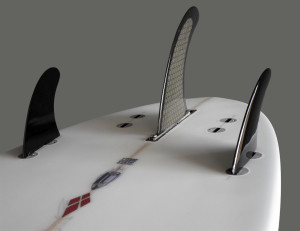
I think Kelly had the right idea marrying the two together and he did this by going very short and widening the nose which suited the quad and as a thruster it did not feel front heavy because it was so short. I guess the dilemma in trying to marry the two concepts is that a thruster does not handle being too wide in the tail (especially in power) where the quad does, and the thruster: if too wide in the nose will always feel front heavy because you are anchored to the tail because of the location of the rear centre fin.
The quad ideally prefers more area forward which gives it drive without being front heavy because the fin clusters are closer together which make the board looser and therefore the wider nose can be flicked around with ease. Having said all this, there are still many five finners on the market right now, and just by looking at them I can tell in what mode they are going to perform best. The advent of the small centre keels have also added another dimension to the quads and given many shapers a real reason for the centre fin. The keel should be placed further back than the trailors in order to give the quad a little more rear purchase when in pivot mode.
The centre feel is emphasised a little more also with a keel ,which I have found besides all the other benefits acts as trainer wheels for those who are in the process of transitioning to quads after being on thrusters for decades. Perhaps there is one novel way where the quad planshape can be married comfortably into a three fin design. Take a look at the 2+1 option.
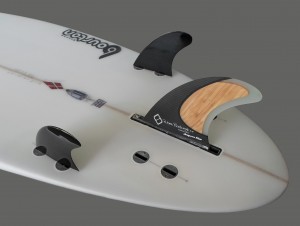 There are some great exponents of this design around- namely Wayne Lynch and Neil Purchase Junior who rip on the bloody things. The trick here is to have a bigger centre fin 6” inches or so in depth and move it forward up around 5” from the tail which in essence moves it closer to the front side fins effectively tightening the cluster Then use the rear trailors (providing they are side fins) and place them up front as side bights.
There are some great exponents of this design around- namely Wayne Lynch and Neil Purchase Junior who rip on the bloody things. The trick here is to have a bigger centre fin 6” inches or so in depth and move it forward up around 5” from the tail which in essence moves it closer to the front side fins effectively tightening the cluster Then use the rear trailors (providing they are side fins) and place them up front as side bights.
This gives the alpha centre fin full control over the side fins and allows one to pivot tightly and go more vert but without loss of speed since the deeper fin generates more reach and run. Because the cluster is so tight the wider nose can be thrown from rail to rail with ease. The depth of the centre fin is also deep enough to deal with the extra tail width caused by it being moved further up the board, so it does not spin out during big bottom turns. The fact that the front side fins are smaller they take the pressure off the rear alpha and let it have its way.
I think we will in the future see a little more interest in this mode addition in the quads, because there are waves that quads just don’t like- namely peaky waves, but for the Tri they are just what the doctor ordered! So hopefully now after having understood how the 5 finners evolved you may have more informed expectations on what they will do and not do, and if you are leaning one way or another then go for the” master of one”!
